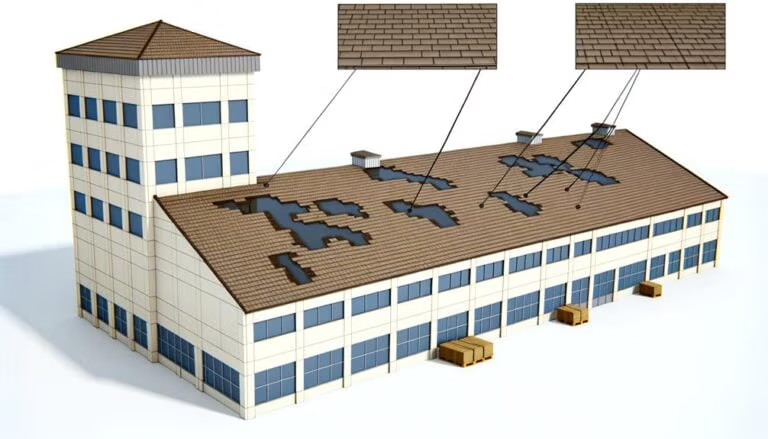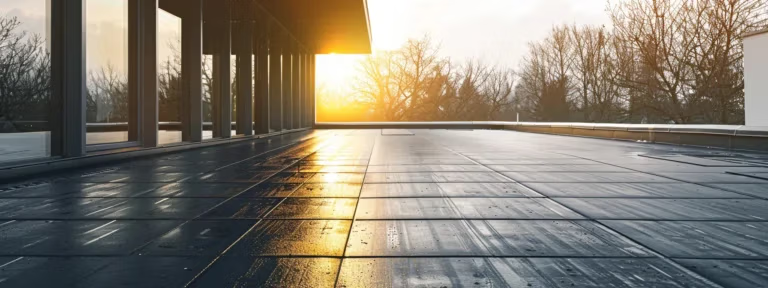I want to explain that three types of flat roofing systems commonly installed by contractors across the United States. Of the three types, EPDM is the most popular and has been used for over 40 years. It is the same synthetic rubber membrane used to make inner tubes.
Another type is TPO, which is a thermoplastic membrane, and finally there’s modified bitumen, which is an asphalt based membrane. Let me explain more about each of these membranes. EPDM is produced in different thicknesses. They are 45, 60, and 90 thousandths of an inch. Most contractors use the industry standard of 60 thousandths of an inch, which is somewhat near the thickness of a quarter.
Some advantages for using EPDM on a flat roof
- It is the least expensive system to install per square foot.
- It is simple to install with the use of anchors, adhesives, and rollers.
- Also, it weighs less than other single ply membranes
- It is sold in wide rolls of eight to twenty feet, resulting in fewer seams.
Some of the disadvantages
- It can be very harmful ultraviolet rays degrade adhesives used on seams and flashing causing very premature separation.
- The protective mats are definitely needed because the thin membrane is susceptible to punctures due to foot traffic on sharp objects left behind by maintenance crews.
- EPDM can easily puncture.
- Repairs to seams and flashing is required long before the warranty of the fifteen to twenty years expires.
- The surface preparation can be an added labor costs when removing an old roof system or installing one over a pre-existing one, and lastly the black color of the membrane absorbs heat and can lead to the super heating of the structure below, causing air conditioning costs to rise significantly.
Now on to TPO.
TPO is another type of roofing membrane there are two thickness options to TPO 45 and 60 thousands of an inch which is roughly equivalent to the thickness of the quarter. TPO is composed of laminated layers. Of the three membranes, this one requires more experienced roofing technicians and much more equipment.
Advantages of TPO
- Heat can weld rather than glued so they are much less prone to separation.
- The white surface of the membrane reflects much of the ultraviolet light, keeping the structure cooler.
- If the contractor is certified by the manufacturer to install the membrane, the manufacturer rather than the contractor honors the warranty.
Here are some of the disadvantages the TPO.
- The system is fairly new to the roofing industry, about 15 years, and has a long track record of revisions and improvements due to surface and seam failures.
- TPO is known to shrink, and its rigidity causes stress on the seams and flashing.
- A prolonged period of excessive heat exposure causes ultraviolet light degradation.
- Another con is that contractors must calibrate their welding machines very carefully. Improperly welded seams may come loose during the first freeze and thaw cycle and lead to water infiltration. Lastly, the manufacturer’s warranty is only fifteen to twenty years. Now, let us talk about the modified bitumen torch down membrane that has been around since the late nineteen sixties.
Now on to Single-Ply Membranes
- It”s is designed to be flexible in extremely hot and cold weather
- It is a two ply membrane with a thickness of about five quarters, or 3/8 of an inch, which is very puncture resistant.
- The membrane surface has been embedded with granular ceramics to protect it from ultraviolet degradation. Also, seams are fused together with high heat to prevent any separation. Unlike EPDM and TPO, the two to three ply systems can withstand a heavy amount of foot traffic.
- Also, this two ply system can be installed over any existing roof or surface, with minimal preparation. Re-roof it and we decided to go over it because rather than strip all the gravel off and all the old tar we save them a lot of cost by going directly over and I started about an hour ago, and this is our fiberglass liner that I’m laying down right now.
- You can see no the UVs has not eaten up the roof and you can see the seams are nice.
- Now, instead of removing this old system and installing a new roof, which most people will do EPDM or TPO, that would be the worst thing to do. You have a modified torch down here the best system in the industry is to have a two ply system; two ply membrane.






